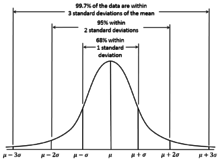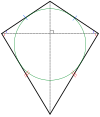Reflection symmetry

수학(mathematics)에서, 반사 대칭(reflection symmetry), 직선 대칭(line symmetry), 거울 대칭(mirror symmetry), 또는 거울-이미지 대칭(mirror-image symmetry)은 반사(reflection)에 관한 대칭(symmetry)입니다. 즉, 반사를 받아도 변하지 않는 도형은 반사적 대칭을 가집니다.
2D에서 대칭의 직선/축이 있으며, 3D에서 대칭의 평면(plane)이 있습니다. 변형된 이미지와 구별할 수 없는 대상 또는 도형은 거울 대칭적(mirror symmetric)이라고 불립니다. 결론적으로, 대칭의 직선은 모양을 절반으로 나누고 그것들의 절반은 동일해야 합니다.
Symmetric function

형식적 용어에서, 수학적 대상(mathematical object)은 반사, 회전(rotation), 또는 평행이동(translation)과 같은 주어진 연산(operation)에 관해, 만약, 대상에 적용될 때, 이 연산이 대상의 일부 속성을 보존하면, 대칭적입니다.[1] 대상의 주어진 속성을 보존하는 연산의 집합은 그룹(group)을 형성합니다. 두 대상은 만약 우리가 일부 연산에 의해 나머지 하나의 다른 대상에서 얻어지면 (또는 그 반대이면) 주어진 연산의 그룹에 관핸 서로 대칭적입니다.
이-차원 도형의 대칭적 함수는 구성된 각 수직선(perpendicular)에 대해 만약 수직선이 수직선을 따라 축에서 거리 'd'에 있는 도형과 교차하면, 축에서 같은 거리 'd'에서 수직선을 따라 반대 방향에서 모양과 수직선의 또 다른 교차점이 존재함을 만족하는 직선입니다.
대칭적 함수에 대해 생각하는 또 다른 방법은 만약 모양이 축에 걸쳐 반으로 접히게 되면, 둘의 반쪽이 동일하다는 것입니다: 둘의 반쪽은 서로의 거울 이미지(mirror image)입니다.[1]
따라서 정사각형은 넷의 대칭 축을 가지는데, 왜냐하면 정사각형을 접고 모두 일치하는 가장자리를 가지기 위한 넷의 다른 방법이 있기 때문입니다. 원은 무한하게 많은 대칭의 축을 가집니다.
Symmetric geometrical shapes

|

|
| isosceles trapezoid and kite | |
|---|---|

|

|
| Hexagons | |

|

|
| octagons | |
반사 대칭을 갖는 삼각형(triangle)은 이등변(isosceles)입니다. 반사 대칭을 갖는 사변형(quadrilateral)은 연(kite), (오목) 델토이드, 마름모(rhombi),[2] 및 이등변 사다리꼴(isosceles trapezoid)입니다. 모든 짝수-변 다각형은 둘의 단순 반사 형식을 가지며, 꼭짓점을 통한 반사의 직선을 갖는 하나와 가장자리를 통한 반사 직선을 갖는 하나가 있습니다.
임의적인 모양에 대해, 모양의 축성(axiality)은 양측적인 대칭에 얼마나 가까운지를 측정합니다. 그것은 반사 대칭을 갖는 모양에 대해 1이고, 임의의 볼록 모양에 대해 2/3에서 1 사이입니다.
Mathematical equivalents
반사의 각 직선 또는 평면에 대해, 대칭 그룹(symmetry group)은 Cs와 동형적이며 (삼 차원에서 점 그룹을 참조), 차수 이의 셋의 유형 중 하나 (인볼루션)이고, 따라서 대수적으로 C2입니다. 기본 도메인(fundamental domain)은 반-평면 또는 반-공간입니다.
특정 문맥에서, 회전 대칭과 마찬가지로 반사 대칭이 있습니다. 그런-다음 거울-이미지 대칭은 반전 대칭과 동등합니다; 현대 물리학에서 이러한 문맥에서, 용어 패리티(parity) 또는 P-대칭은 둘 다에 대해 사용됩니다.
Advanced types of reflection symmetry
더 일반적인 반사(reflection)의 유형에 대해, 상응하게 반사 대칭의 보다 일반적인 유형이 있습니다. 예를 들어:
- 비-동형적 아핀 인볼루션(affine involution) (직선, 평면 등에서 비스듬한 반사(oblique reflection))과 관련하여
- 원 반전(circle inversion)과 관련하여.
In nature

양측으로 대칭인 동물은 신체를 수직으로 좌우 반으로 나누는 시상 평면에서 반사 대칭을 가지며, 양쪽에 각 감각 기관과 팔다리 쌍이 있습니다. 대부분의 동물은 양측 대칭이며, 이것은 앞으로의 움직임과 유선형을 지원하기 때문일 수 있습니다.[3][4][5][6]
In architecture

거울 대칭은 종종 피렌체의 산타 마리아 노벨라(Santa Maria Novella)의 정면에서와 같이 건축(architecture)에서 사용됩니다.[7] 그것은 역시 스톤헨지(Stonehenge)와 같은 고대 건축물의 설계에서 발견됩니다.[8] 대칭은 팔라디오주의(Palladianism)와 같은 일부 건축 스타일의 핵심 요소였습니다.[9]
See also
- Patterns in nature
- Point reflection symmetry
References
- ^ a b Stewart, Ian (2001). What Shape is a Snowflake? Magical Numbers in Nature. Weidenfeld & Nicolson. p. 32.
- ^ Gullberg, Jan (1997). Mathematics: From the Birth of Numbers. W. W. Norton. pp. 394–395. ISBN 0-393-04002-X.
- ^ Valentine, James W. "Bilateria". AccessScience. Retrieved 29 May 2013.
- ^ "Bilateral symmetry". Natural History Museum. Retrieved 14 June 2014.
- ^ Finnerty, John R. (2005). "Did internal transport, rather than directed locomotion, favor the evolution of bilateral symmetry in animals?" (PDF). BioEssays. 27 (11): 1174–1180. doi:10.1002/bies.20299. PMID 16237677.
- ^ "Bilateral (left/right) symmetry". Berkeley. Retrieved 14 June 2014.
- ^ Tavernor, Robert (1998). On Alberti and the Art of Building. Yale University Press. pp. 102–106. ISBN 978-0-300-07615-8.
More accurate surveys indicate that the facade lacks a precise symmetry, but there can be little doubt that Alberti intended the composition of number and geometry to be regarded as perfect. The facade fits within a square of 60 Florentine braccia
- ^ Johnson, Anthony (2008). Solving Stonehenge: The New Key to an Ancient Enigma. Thames & Hudson.
- ^ Waters, Suzanne. "Palladianism". Royal Institution of British Architects. Retrieved 29 October 2015.
Bibliography
General
- Stewart, Ian (2001). What Shape is a Snowflake? Magical Numbers in Nature. Weidenfeld & Nicolson.
Advanced
- Weyl, Hermann (1982) [1952]. Symmetry. Princeton: Princeton University Press. ISBN 0-691-02374-3.
External links
